My
List |
Addition Date
|
Target
|
Mission
|
Instrument
|
Size
|

|
2005-05-30 |
Carina Nebula
|
Spitzer Space Telescope
|
IRAC
|
6614x5196x3 |

|
-
PIA03515:
-
All Pillars Point to Eta

Full Resolution:
TIFF
(103.1 MB)
JPEG
(3.749 MB)
|

|
2005-06-10 |
Cassiopeia A
|
Spitzer Space Telescope
|
IRAC
|
2826x774x3 |

|
-
PIA03517:
Dead Star Rumbles
Full Resolution:
TIFF
(6.562 MB)
JPEG
(138.9 kB)
|

|
2005-06-10 |
Cassiopeia A
|
Spitzer Space Telescope
|
IRAC
|
2842x1622x3 |

|
-
PIA03518:
-
A Year in the Life of an Infrared Echo
Full Resolution:
TIFF
(13.83 MB)
JPEG
(301.2 kB)
|

|
2006-01-11 |
G29-38
|
Spitzer Space Telescope
|
Infrared Spectrometer (IRS)
|
3000x2400x3 |

|
-
PIA03652:
-
Comet 'Bites the Dust' Around Dead Star (Artist Concept)
Full Resolution:
TIFF
(21.6 MB)
JPEG
(298.4 kB)
|

|
2005-10-13 |
M31
|
Spitzer Space Telescope
|
MIPS
|
8193x2410x3 |

|
-
PIA03031:
-
Amazing Andromeda in Red
Full Resolution:
TIFF
(19.75 MB)
JPEG
(3.247 MB)
|

|
2005-10-20 |
|
Spitzer Space Telescope
|
|
3000x2400x3 |

|
-
PIA03048:
-
Sowing the Seeds of Planets? (Artist's Concept)
Full Resolution:
TIFF
(21.6 MB)
JPEG
(301.7 kB)
|

|
2005-10-27 |
|
Spitzer Space Telescope
|
IRAC
|
561x561x3 |

|
-
PIA03543:
-
A SWIRE Picture is Worth Billions of Years
Full Resolution:
TIFF
(945.5 kB)
JPEG
(39.8 kB)
|

|
2005-10-28 |
|
Spitzer Space Telescope
|
IRAC
|
1600x1600x3 |

|
-
PIA03544:
-
Black Widow Nebula Hiding in the Dust
Full Resolution:
TIFF
(7.693 MB)
JPEG
(323.3 kB)
|

|
2005-11-09 |
|
Spitzer Space Telescope
|
IRAC
|
3426x2548x3 |

|
-
PIA03096:
-
Towering Infernos
Full Resolution:
TIFF
(26.19 MB)
JPEG
(900.3 kB)
|

|
2005-11-15 |
Perseus
|
Spitzer Space Telescope
|
IRAC
|
1291x1663x3 |

|
-
PIA03545:
-
Chaotic Star Birth
Full Resolution:
TIFF
(6.448 MB)
JPEG
(257.1 kB)
|

|
2005-12-01 |
|
Spitzer Space Telescope
|
IRAC
|
848x711x3 |

|
-
PIA03605:
-
Dwarf Galaxies Swimming in Tidal Tails
Full Resolution:
TIFF
(1.811 MB)
JPEG
(60.3 kB)
|

|
2005-12-13 |
Milky Way
|
Spitzer Space Telescope
|
IRAC
|
27000x6000x3 |

|
-
PIA03239:
A Glimpse of the Milky Way
Full Resolution:
TIFF
(486 MB)
JPEG
(37.05 MB)
|

|
2005-12-20 |
IRS 46
|
Spitzer Space Telescope
|
Infrared Spectrograph (IRS)
|
3000x2128x3 |

|
-
PIA03242:
-
Life's Starting Materials Found in Dusty Disk
Full Resolution:
TIFF
(19.15 MB)
JPEG
(290.4 kB)
|

|
2005-12-20 |
IRS 46
|
Spitzer Space Telescope
|
|
3000x2400x3 |

|
-
PIA03243:
-
Portrait of Our Dusty Past (Artist Concept)
Full Resolution:
TIFF
(21.6 MB)
JPEG
(361.6 kB)
|

|
2005-12-22 |
|
Spitzer Space Telescope
|
IRAC
Multiband Imaging Photometer (MIPS)
|
2310x3897x3 |

|
-
PIA03244:
-
Stellar Snowflake Cluster
Full Resolution:
TIFF
(27.04 MB)
JPEG
(801.6 kB)
|

|
2006-01-09 |
Helix Nebula
|
Spitzer Space Telescope
|
IRAC
|
2400x2794x3 |

|
-
PIA03294:
-
The Infrared Helix
Full Resolution:
TIFF
(20.14 MB)
JPEG
(1.082 MB)
|

|
2006-01-10 |
Milky Way
|
Spitzer Space Telescope
|
IRAC
|
7002x5050x3 |
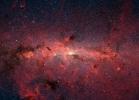
|
-
PIA03654:
-
A Cauldron of Stars at the Galaxy's Center
Full Resolution:
TIFF
(106.1 MB)
JPEG
(7.727 MB)
|

|
2006-01-10 |
Milky Way
|
Spitzer Space Telescope
|
IRAC
|
7002x5050x3 |

|
-
PIA03653:
-
The Milky Way Center Aglow with Dust
Full Resolution:
TIFF
(106.1 MB)
JPEG
(3.431 MB)
|

|
2006-02-08 |
R 66
|
Spitzer Space Telescope
|
Infrared Spectrometer (IRS)
|
5140x2400x3 |

|
-
PIA08006:
-
Supersized Disk (Artist's Concept)
Full Resolution:
TIFF
(37.01 MB)
JPEG
(435.5 kB)
|

|
2006-02-15 |
|
Spitzer Space Telescope
|
IRAC
|
706x869x3 |

|
-
PIA08007:
-
Galaxy NGC 4579
Full Resolution:
TIFF
(1.843 MB)
JPEG
(35.48 kB)
|

|
2006-02-15 |
|
Spitzer Space Telescope
|
Infrared Spectrograph (IRS)
|
3000x2400x3 |

|
-
PIA02180:
-
Galactic Hearts of Glass (Artist Concept)
Full Resolution:
TIFF
(21.6 MB)
JPEG
(875.8 kB)
|

|
2006-03-03 |
|
Spitzer Space Telescope
|
IRAC
Near Infrared Spectrometer
|
966x966x3 |

|
-
PIA02587:
-
A Shocking Surprise in Stephan's Quintet
Full Resolution:
TIFF
(2.804 MB)
JPEG
(87.19 kB)
|

|
2006-03-16 |
|
Spitzer Space Telescope
|
IRAC
|
480x640x3 |
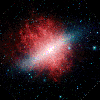
|
-
PIA02917:
-
Smokin' Hot Galaxy (animation)

Full Resolution:
TIFF
(6.619 MB)
JPEG
(163.8 kB)
|

|
2006-03-21 |
|
Spitzer Space Telescope
|
IRAC
|
2243x2240x3 |

|
-
PIA02038:
-
Great Galactic Buddies
Full Resolution:
TIFF
(15.09 MB)
JPEG
(698.3 kB)
|

|
2006-04-05 |
|
Spitzer Space Telescope
|
|
3200x2400x3 |

|
-
PIA08040:
-
Stellar Rubble May be Planetary Building Blocks (Artist Concept)

Full Resolution:
TIFF
(23.04 MB)
JPEG
(721.1 kB)
|

|
2006-04-05 |
|
Spitzer Space Telescope
|
|
3000x2400x3 |

|
-
PIA08042:
-
Extreme Planets (Artist Concept)
Full Resolution:
TIFF
(21.6 MB)
JPEG
(351.9 kB)
|

|
2006-04-26 |
|
Spitzer Space Telescope
|
IRAC
|
1010x1010x3 |

|
-
PIA08098:
-
Ready for the Cosmic Ball
Full Resolution:
TIFF
(3.065 MB)
JPEG
(65.47 kB)
|

|
2006-05-11 |
|
Spitzer Space Telescope
|
IRAC
MIPS
Visible Light
|
900x859x3 |

|
-
PIA08453:
-
The (Almost) Invisible Aftermath of a Massive Star's Death
Full Resolution:
TIFF
(2.322 MB)
JPEG
(104 kB)
|

|
2006-06-05 |
Messier 31
|
Spitzer Space Telescope
|
IRAC
|
720x486x3 |

|
-
PIA08506:
-
Fade to Red

Full Resolution:
TIFF
(219.5 MB)
JPEG
(10.51 MB)
|

|
2006-06-05 |
|
Spitzer Space Telescope
|
IRAC
Mosaic-I Camera
Mayall 4-Meter Telescope
|
1114x1380x3 |

|
-
PIA08509:
-
Galaxies Gather at Great Distances
Full Resolution:
TIFF
(4.618 MB)
JPEG
(365.3 kB)
|

|
2006-06-09 |
|
Spitzer Space Telescope
|
IRAC
|
2325x2329x3 |

|
-
PIA08533:
-
Supernova Dust Factory in M74
Full Resolution:
TIFF
(16.26 MB)
JPEG
(325.5 kB)
|

|
2006-07-24 |
|
Spitzer Space Telescope
|
|
3200x2400x3 |
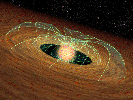
|
-
PIA08626:
-
Stars Can't Spin Out of Control (Artist's Animation)

Full Resolution:
TIFF
(23.04 MB)
JPEG
(714.7 kB)
|

|
2006-08-15 |
Orion
|
Spitzer Space Telescope
|
IRAC
|
3220x6000x3 |

|
-
PIA08653:
-
The Sword of Orion

Full Resolution:
TIFF
(57.96 MB)
JPEG
(738.3 kB)
|

|
2006-08-15 |
Orion
|
Spitzer Space Telescope
|
IRAC
|
2240x2086x3 |

|
-
PIA08654:
-
The Infrared Hunter
Full Resolution:
TIFF
(14.03 MB)
JPEG
(324.9 kB)
|

|
2006-08-15 |
Orion
|
Spitzer Space Telescope
|
IRAC
|
19937x6972x3 |

|
-
PIA08655:
-
A Slice of Orion
Full Resolution:
TIFF
(417 MB)
JPEG
(5.782 MB)
|

|
2006-08-15 |
Orion
|
Spitzer Space Telescope
|
IRAC
|
3000x1800x3 |

|
-
PIA08656:
-
Infrared Spotlight on Orion's Sword
Full Resolution:
TIFF
(16.2 MB)
JPEG
(328.7 kB)
|

|
2006-09-01 |
|
Spitzer Space Telescope
|
IRAC
|
6000x6000x3 |

|
-
PIA07136:
-
Our Chaotic Neighbor
Full Resolution:
TIFF
(108 MB)
JPEG
(11.3 MB)
|

|
2006-09-01 |
|
Spitzer Space Telescope
|
IRAC
Multiband Imaging Photometer (MIPS)
|
6000x6000x3 |
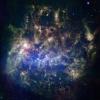
|
-
PIA07137:
-
What's Old is New in the Large Magellanic Cloud
Full Resolution:
TIFF
(108 MB)
JPEG
(8.784 MB)
|

|
2008-01-10 |
NGC 3621
|
Spitzer Space Telescope
|
Infrared Spectrograph (IRS)
|
3000x2400x3 |

|
-
PIA10220:
-
Slender Galaxy with Robust Black Hole
Full Resolution:
TIFF
(21.6 MB)
JPEG
(326.6 kB)
|

|
2006-10-12 |
|
Spitzer Space Telescope
|
|
640x479x3 |

|
-
PIA01936:
-
Fire and Ice Planet (Artist Concept)

Full Resolution:
TIFF
(920.9 kB)
JPEG
(22.82 kB)
|

|
2006-10-12 |
|
Spitzer Space Telescope
|
MIPS
|
2396x2680x3 |

|
-
PIA01937:
-
The Light and Dark Sides of a Distant Planet
Full Resolution:
TIFF
(19.29 MB)
JPEG
(812.9 kB)
|

|
2006-10-12 |
|
Spitzer Space Telescope
|
|
2400x3200x3 |

|
-
PIA01938:
-
Exotic World Blisters Under the Sun (Artist Concept)
Full Resolution:
TIFF
(23.07 MB)
JPEG
(308.3 kB)
|

|
2006-10-26 |
Cassiopeia A
|
Spitzer Space Telescope
|
|
2400x3000x3 |

|
-
PIA01901:
-
Once an Onion, Always an Onion (Artist Concept)
Full Resolution:
TIFF
(21.62 MB)
JPEG
(576.9 kB)
|

|
2006-10-26 |
Cassiopeia A
|
Spitzer Space Telescope
|
IRAC
|
638x477x3 |

|
-
PIA01902:
-
Order Amidst Chaos of Star's Explosion (Artist Concept)

Full Resolution:
TIFF
(914.2 kB)
JPEG
(56.6 kB)
|

|
2006-10-26 |
Cassiopeia A
|
Spitzer Space Telescope
|
IRAC
|
1600x1600x3 |

|
-
PIA01903:
-
Lighting up a Dead Star's Layers
Full Resolution:
TIFF
(7.693 MB)
JPEG
(218 kB)
|

|
2006-10-27 |
|
Spitzer Space Telescope
|
IRAC
Multiband Imaging Photometer (MIPS)
|
3000x2300x3 |

|
-
PIA01318:
-
Where Galactic Snakes Live
Full Resolution:
TIFF
(20.7 MB)
JPEG
(1.154 MB)
|

|
2006-10-03 |
|
Spitzer Space Telescope
|
MIPS
|
1500x558x3 |

|
-
PIA01319:
-
A Star's Close Encounter
Full Resolution:
TIFF
(839.7 kB)
JPEG
(43.53 kB)
|

|
2006-10-27 |
|
Spitzer Space Telescope
|
IRAC
Multiband Imaging Photometer (MIPS)
|
2448x2244x3 |

|
-
PIA01320:
-
Dead Star Creates Celestial Havoc
Full Resolution:
TIFF
(16.5 MB)
JPEG
(466.2 kB)
|

|
2006-11-07 |
|
Spitzer Space Telescope
|
IRAC
Ultraviolet/Visible Camera
|
6000x6000x3 |

|
-
PIA01322:
-
Chaos at the Heart of Orion
Full Resolution:
TIFF
(108 MB)
JPEG
(1.536 MB)
|

|
2006-12-08 |
|
Spitzer Space Telescope
|
IRAC
|
2320x2420x3 |

|
-
PIA09071:
-
Stellar Debris in the Large Magellanic Cloud
Full Resolution:
TIFF
(16.86 MB)
JPEG
(373.3 kB)
|

|
2006-12-08 |
|
Spitzer Space Telescope
|
MIPS
|
2861x1439x3 |

|
-
PIA09070:
-
Red Giant Plunging Through Space
Full Resolution:
TIFF
(12.35 MB)
JPEG
(212.3 kB)
|

|
2006-12-08 |
|
Spitzer Space Telescope
|
IRAC
|
3000x2141x3 |

|
-
PIA09072:
-
Seeing Stars in Serpens
Full Resolution:
TIFF
(19.27 MB)
JPEG
(752 kB)
|

|
2006-12-18 |
|
Spitzer Space Telescope
|
|
644x481x3 |

|
-
PIA09099:
-
Stars Spring up Out of the Darkness (Artist Concept)

Full Resolution:
TIFF
(930.5 kB)
JPEG
(22 kB)
|

|
2006-12-18 |
|
Spitzer Space Telescope
|
IRAC
|
2430x1525x3 |

|
-
PIA09100:
-
The Universe's First Fireworks
Full Resolution:
TIFF
(11.13 MB)
JPEG
(405.3 kB)
|

|
2007-01-09 |
|
Spitzer Space Telescope
|
IRAC
Multiband Imaging Photometer (MIPS)
|
2100x2400x3 |

|
-
PIA09108:
-
Eagle Nebula Flaunts its Infrared Feathers
Full Resolution:
TIFF
(15.14 MB)
JPEG
(1.048 MB)
|

|
2007-01-26 |
|
Spitzer Space Telescope
|
|
3000x2400x3 |

|
-
PIA09117:
-
Gas Giants Form Quickly (Artist Concept)
Full Resolution:
TIFF
(21.6 MB)
JPEG
(205.5 kB)
|

|
2007-01-26 |
|
Spitzer Space Telescope
|
|
3200x2400x3 |

|
-
PIA09118:
-
Forecasting Weather on Distant Worlds (Artist Concept)
Full Resolution:
TIFF
(23.04 MB)
JPEG
(277.9 kB)
|

|
2007-01-26 |
|
Spitzer Space Telescope
|
IRAC
|
720x720x3 |

|
-
PIA09119:
-
Luminous Blue Variable: Destined To Be a Supernova?
Full Resolution:
TIFF
(1.557 MB)
JPEG
(53.65 kB)
|

|
2007-02-12 |
Helix Nebula
|
Spitzer Space Telescope
|
IRAC
Multiband Imaging Photometer (MIPS)
|
4279x3559x3 |

|
-
PIA09178:
-
Comets Kick up Dust in Helix Nebula
Full Resolution:
TIFF
(45.69 MB)
JPEG
(1.944 MB)
|

|
2007-02-21 |
|
Spitzer Space Telescope
|
|
3000x2400x3 |

|
-
PIA09196:
-
How to Pluck a Spectrum from a Planet
Full Resolution:
TIFF
(21.6 MB)
JPEG
(298.3 kB)
|

|
2007-02-21 |
|
Spitzer Space Telescope
|
Infrared Spectrograph (IRS)
|
3000x2400x3 |

|
-
PIA09197:
-
Cracking the Code of Faraway Worlds
Full Resolution:
TIFF
(21.6 MB)
JPEG
(399.2 kB)
|

|
2007-02-21 |
|
Spitzer Space Telescope
|
Infrared Spectrograph (IRS)
|
3000x2400x3 |

|
-
PIA09198:
-
Cracking the Code of Faraway Worlds
Full Resolution:
TIFF
(21.6 MB)
JPEG
(484.3 kB)
|

|
2007-02-21 |
|
Spitzer Space Telescope
|
Infrared Spectrograph (IRS)
|
3000x2400x3 |

|
-
PIA09199:
-
Cracking the Code of Faraway Worlds
Full Resolution:
TIFF
(21.6 MB)
JPEG
(354 kB)
|

|
2007-02-21 |
|
Spitzer Space Telescope
|
|
3000x2400x3 |

|
-
PIA09200:
-
Exotic Atmospheres
(Artist Concept)

Full Resolution:
TIFF
(21.6 MB)
JPEG
(257.1 kB)
|

|
2007-03-29 |
|
Spitzer Space Telescope
|
IRAC
|
3000x2400x3 |

|
-
PIA09227:
-
Where Planets Take up Residence
Full Resolution:
TIFF
(21.6 MB)
JPEG
(348.8 kB)
|

|
2007-03-29 |
|
Spitzer Space Telescope
|
|
3000x2000x3 |

|
-
PIA09228:
-
Alien Sunset (Artist Concept)
Full Resolution:
TIFF
(18 MB)
JPEG
(239.4 kB)
|

|
2007-03-29 |
|
Spitzer Space Telescope
|
|
3000x2400x3 |

|
-
PIA09229:
-
Two Suns Raise Family of Planetary Bodies (Artist Animation)

Full Resolution:
TIFF
(21.6 MB)
JPEG
(309.2 kB)
|

|
2007-04-16 |
Pleiades
|
Spitzer Space Telescope
|
IRAC
|
2855x2855x3 |

|
-
PIA09262:
-
Pink Pleiades
Full Resolution:
TIFF
(24.45 MB)
JPEG
(980.3 kB)
|

|
2007-04-16 |
Pleiades
|
Spitzer Space Telescope
|
IRAC
Multiband Imaging Photometer (MIPS)
|
2855x2855x3 |

|
-
PIA09263:
-
The Seven Sisters Pose for Spitzer
Full Resolution:
TIFF
(24.45 MB)
JPEG
(779.5 kB)
|

|
2007-04-18 |
Rosette Nebula
|
Spitzer Space Telescope
|
|
3300x2400x3 |
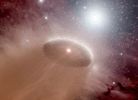
|
-
PIA09266:
-
Highway to the Danger Zone (Artist Concept)

Full Resolution:
TIFF
(23.76 MB)
JPEG
(244.6 kB)
|

|
2007-04-18 |
Rosette Nebula
|
Spitzer Space Telescope
|
IRAC
|
1669x1439x3 |

|
-
PIA09267:
-
Every Rose has a Thorn
Full Resolution:
TIFF
(7.217 MB)
JPEG
(286.2 kB)
|

|
2007-04-18 |
Rosette Nebula
|
Spitzer Space Telescope
|
IRAC
|
639x479x3 |

|
-
PIA09268:
-
Infrared Rose

Full Resolution:
TIFF
(919.4 kB)
JPEG
(54.85 kB)
|

|
2007-05-01 |
|
Spitzer Space Telescope
|
IRAC
Visible Light
|
2838x948x3 |

|
-
PIA09338:
-
Spitzer Digs Up Hidden Stars
Full Resolution:
TIFF
(8.071 MB)
JPEG
(398.7 kB)
|

|
2007-05-09 |
HD 189733b
|
Spitzer Space Telescope
|
IRAC
|
640x473x3 |

|
-
PIA09376:
-
First Map of Alien World (animation)

Full Resolution:
TIFF
(909.3 kB)
JPEG
(23.38 kB)
|

|
2007-05-09 |
HD 189733b
|
Spitzer Space Telescope
|
IRAC
|
640x467x3 |

|
-
PIA09377:
-
How to Map a Very Faraway Planet (animation)

Full Resolution:
TIFF
(897.8 kB)
JPEG
(11.68 kB)
|

|
2007-05-09 |
HD 149026b
|
Spitzer Space Telescope
|
|
638x479x3 |

|
-
PIA09378:
-
Blacker than Black (Artist's Concept)

Full Resolution:
TIFF
(918 kB)
JPEG
(12.32 kB)
|

|
2007-05-17 |
Barnard 30
|
Spitzer Space Telescope
|
IRAC
Multiband Imaging Photometer (MIPS)
|
3182x1282x3 |

|
-
PIA09411:
-
Young Stars Emerge from Orion's Head
Full Resolution:
TIFF
(12.24 MB)
JPEG
(490.4 kB)
|

|
2007-05-17 |
Barnard 30
|
Spitzer Space Telescope
|
IRAC
|
3086x1711x3 |

|
-
PIA09412:
-
Young Stars Emerge from Orion's Head
Full Resolution:
TIFF
(15.84 MB)
JPEG
(627.4 kB)
|

|
2007-05-29 |
|
Spitzer Space Telescope
|
IRAC
|
4097x3557x3 |

|
-
PIA09561:
-
Dwarfs in Coma Cluster
Full Resolution:
TIFF
(43.72 MB)
JPEG
(1.199 MB)
|

|
2007-06-13 |
N132D
|
Spitzer Space Telescope
|
Chandra X-ray Telescope
Infrared Array Camera (IRAC)
Multiband Imaging Photometer (MIPS)
|
1806x1200x3 |
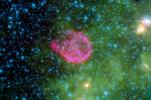
|
-
PIA09604:
-
A Supernova's Shockwaves
Full Resolution:
TIFF
(6.511 MB)
JPEG
(206.6 kB)
|

|
2007-07-11 |
HD 189733b
|
Spitzer Space Telescope
|
Infrared Spectrograph (IRS)
|
3000x2136x3 |
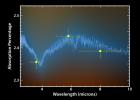
|
-
PIA09715:
-
Exoplanet Forecast: Hot and Wet
Full Resolution:
TIFF
(19.22 MB)
JPEG
(259.2 kB)
|

|
2007-07-24 |
|
Spitzer Space Telescope
|
|
3000x2400x3 |

|
-
PIA09939:
-
Evidence for Strange Stellar Family (Artist Concept)
Full Resolution:
TIFF
(21.6 MB)
JPEG
(256.6 kB)
|

|
2007-08-06 |
CL0958+4702
|
Spitzer Space Telescope
|
IRAC
|
690x690x3 |
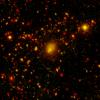
|
-
PIA09955:
-
Fearsome Foursome
Full Resolution:
TIFF
(1.43 MB)
JPEG
(64.28 kB)
|

|
2007-08-06 |
CL0958+4702
|
Spitzer Space Telescope
|
|
3000x2400x3 |

|
-
PIA09956:
-
Fantastic Four Galaxies with Planet (Artist Concept)
Full Resolution:
TIFF
(21.6 MB)
JPEG
(941.8 kB)
|

|
2007-08-06 |
CL0958+4702
|
Spitzer Space Telescope
|
|
3000x2400x3 |

|
-
PIA09957:
-
Galactic Pile-Up (Artist Concept)
Full Resolution:
TIFF
(21.6 MB)
JPEG
(774.2 kB)
|

|
2007-08-24 |
Helix Nebula
|
Spitzer Space Telescope
|
IRAC
|
4370x4070x3 |

|
-
PIA09962:
-
Spitzer Celebrates Fourth Anniversary with Celestial Fireworks
Full Resolution:
TIFF
(53.36 MB)
JPEG
(2.378 MB)
|

|
2007-08-29 |
NGC 1333
|
Spitzer Space Telescope
|
Infrared Spectrograph (IRS)
|
3000x2400x3 |

|
-
PIA09965:
-
Spitzer Sees Water Loud and Clear
Full Resolution:
TIFF
(21.6 MB)
JPEG
(987.8 kB)
|

|
2007-08-29 |
NGC 1333
|
Spitzer Space Telescope
|
IRAC
|
3000x2400x3 |
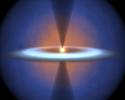
|
-
PIA09966:
-
Steamy Solar System
Full Resolution:
TIFF
(21.6 MB)
JPEG
(167.5 kB)
|

|
2007-08-29 |
NGC 1333
|
Spitzer Space Telescope
|
|
3200x2400x3 |

|
-
PIA09967:
-
Water's Early Journey in a Solar System (Artist Concept)
Full Resolution:
TIFF
(23.04 MB)
JPEG
(336.4 kB)
|

|
2007-09-13 |
|
Spitzer Space Telescope
|
IRAC
Chandra X-ray Telescope
|
3300x3300x3 |

|
-
PIA09925:
-
Coronet: A Star-Formation Neighbor
Full Resolution:
TIFF
(32.67 MB)
JPEG
(407 kB)
|

|
2007-09-13 |
|
Spitzer Space Telescope
|
IRAC
|
3300x3300x3 |

|
-
PIA09926:
-
Infrared Coronet Cluster
Full Resolution:
TIFF
(32.67 MB)
JPEG
(583.5 kB)
|

|
2007-10-03 |
|
Spitzer Space Telescope
|
|
3000x2400x3 |

|
-
PIA09931:
-
Birth of an Earth-like Planet (Artist Xoncept)
Full Resolution:
TIFF
(21.6 MB)
JPEG
(281.9 kB)
|

|
2007-10-09 |
|
Spitzer Space Telescope
|
Infrared Spectrograph (IRS)
|
2865x1749x3 |

|
-
PIA09932:
-
A Wealth of Dust Grains in Quasar Winds
Full Resolution:
TIFF
(15.03 MB)
JPEG
(288.3 kB)
|

|
2007-10-09 |
|
Spitzer Space Telescope
|
Infrared Spectrograph (IRS)
|
3000x2400x3 |

|
-
PIA10019:
-
Dust in the Quasar Wind (Artist Concept)
Full Resolution:
TIFF
(21.6 MB)
JPEG
(291.3 kB)
|

|
2007-10-22 |
|
Spitzer Space Telescope
|
Infrared Spectrometer (IRS)
|
2997x1689x3 |

|
-
PIA10086:
-
Cosmic Caper Unfolds in Infrared
Full Resolution:
TIFF
(15.19 MB)
JPEG
(269.1 kB)
|

|
2007-10-22 |
|
Spitzer Space Telescope
|
IRAC
|
2084x2302x3 |

|
-
PIA10087:
-
Wanted: Galactic Thief Who Steals Gas
Full Resolution:
TIFF
(14.41 MB)
JPEG
(236.2 kB)
|

|
2007-10-25 |
|
Spitzer Space Telescope
|
MIPS
|
1003x1139x3 |

|
-
PIA10091:
-
Missing Black Holes Found!
Full Resolution:
TIFF
(1.145 MB)
JPEG
(69.72 kB)
|

|
2007-10-25 |
|
Spitzer Space Telescope
|
|
3000x2400x3 |

|
-
PIA10093:
-
Bursting with Stars and Black Holes (Artist Concept)
Full Resolution:
TIFF
(21.6 MB)
JPEG
(501.4 kB)
|

|
2007-11-08 |
HH 46/47
|
Spitzer Space Telescope
|
IRAC
|
2000x1600x3 |

|
-
PIA10111:
-
Bubbly Little Star
Full Resolution:
TIFF
(9.613 MB)
JPEG
(240.8 kB)
|

|
2007-11-29 |
L1157
|
Spitzer Space Telescope
|
IRAC
|
1171x1444x3 |

|
-
PIA10119:
-
Baby Picture of our Solar System

Full Resolution:
TIFF
(5.079 MB)
JPEG
(154.9 kB)
|

 Planetary Data System
Planetary Data System





















































































































